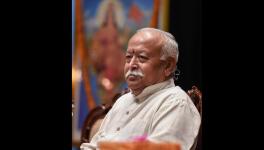Adivasis, Dalits Have Significantly Lower Life Expectancy than Upper Caste Hindus: Study

Dalit women unite to condemn unemployment
The life expectancy of adivasis and dalits in India is significantly lower than upper caste Hindus, according to a study published on March 1, 2022. The authors investigated life expectancy differentials along the lines of caste, religion, and indigenous identity in India.
The authors, Sangita Vyas from the University of Texas, Austin, Payal Hathi from the University of California, Berkeley, and Aashish Gupta from the University of Pennsylvania, used a large, high-quality survey that measured mortality, social group, and economic status to estimate and decompose life expectancy differences between higher-caste Hindus, comprising other backward classes (OBCs) and high-caste Hindus, and three of India’s most disadvantaged social groups: adivasis, dalits, and Muslims.
Relative to higher-caste Hindus, the study found, adivasi life expectancy is more than four years lower, dalit life expectancy is more than three years lower, and Muslim life expectancy is about one year lower. The study said, “Economic status explains less than half of these gaps. The differences between the life expectancy of higher-caste Hindus and the life expectancies of Adivasis and Dalits are comparable to the Black-White gap in the United States in absolute magnitude.” It added, “The differences are larger in relative terms because overall life expectancy in India is lower.”
For the study, published by the Proceedings of the National Academy of Sciences (PNAS), the US, the researchers used India’s Annual Health Survey data from Assam, Bihar, Chhattisgarh, Jharkhand, Madhya Pradesh, Odisha, Rajasthan and Uttar Pradesh, representing 20 million individuals from 4 million households. The data was analysed using sophisticated statistical tools and compared with other data sets to derive the conclusions.
“We observe lower life expectancies at birth among marginalised social groups. Adivasis have the lowest life expectancy among the four groups. Differentials between Adivasis and higher-caste Hindus are 3.7 years for women and almost five years for men,” the study said. The researchers had to club OBCs (other backward classes) with upper-caste Hindus because of the absence of segregated data.
The gap between dalits and higher-caste Hindus is of similar magnitude — more than three years for both women and men- the study highlighted. Muslim life expectancy is about one year less than that of higher-caste Hindus. The life expectancy for dalits and Adivasis is similar to those of the poorest countries in the world, the authors pointed out.

“As in other contexts, social and economic disadvantages occur simultaneously in India. Dalits, Adivasis, and Muslims are poorer than privileged groups. Because health and economic status are also related, we quantify the extent to which differences in socioeconomic status (SES) can account for mortality differences between groups,” the study said.
The study found that life expectancy disparities remain even after accounting for SES. Adivasis and dalits have lower life expectancy than OBC/high caste Hindus across wealth categories. Comparing Muslims and OBC/high-caste Hindus, the authors found similar life expectancies at poorer deciles but lower life expectancies among Muslims at richer deciles.
The authors explained that although a further scientific investigation is needed to understand these patterns, a part of the explanation for why OBC/high-caste Hindu and Muslim life expectancies diverge at richer deciles could be due to differences across deciles in the share of OBCs and high-caste Hindus within the OBC/high-caste Hindu group.
“In addition to having comparatively lower life expectancies, marginalised social groups in India are also larger in terms of population than most countries in the world. Our study, therefore, underscores the global significance of challenging social inequality in health in India. Indeed, extreme social stratification and exploitation in India may be contributing to global population health deficits and slower improvements in health worldwide,” the study said.
Get the latest reports & analysis with people's perspective on Protests, movements & deep analytical videos, discussions of the current affairs in your Telegram app. Subscribe to NewsClick's Telegram channel & get Real-Time updates on stories, as they get published on our website.
























